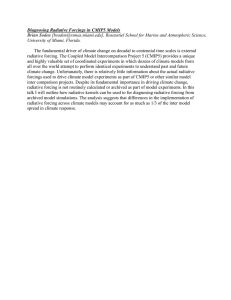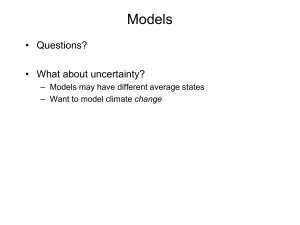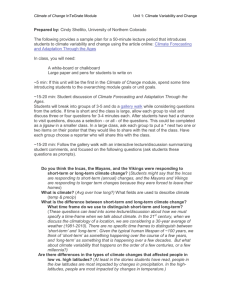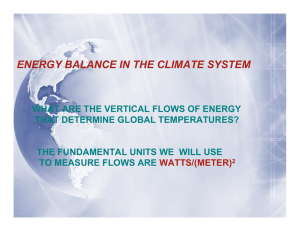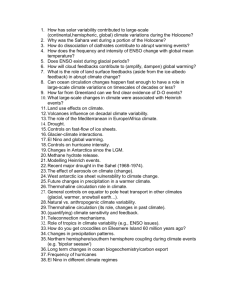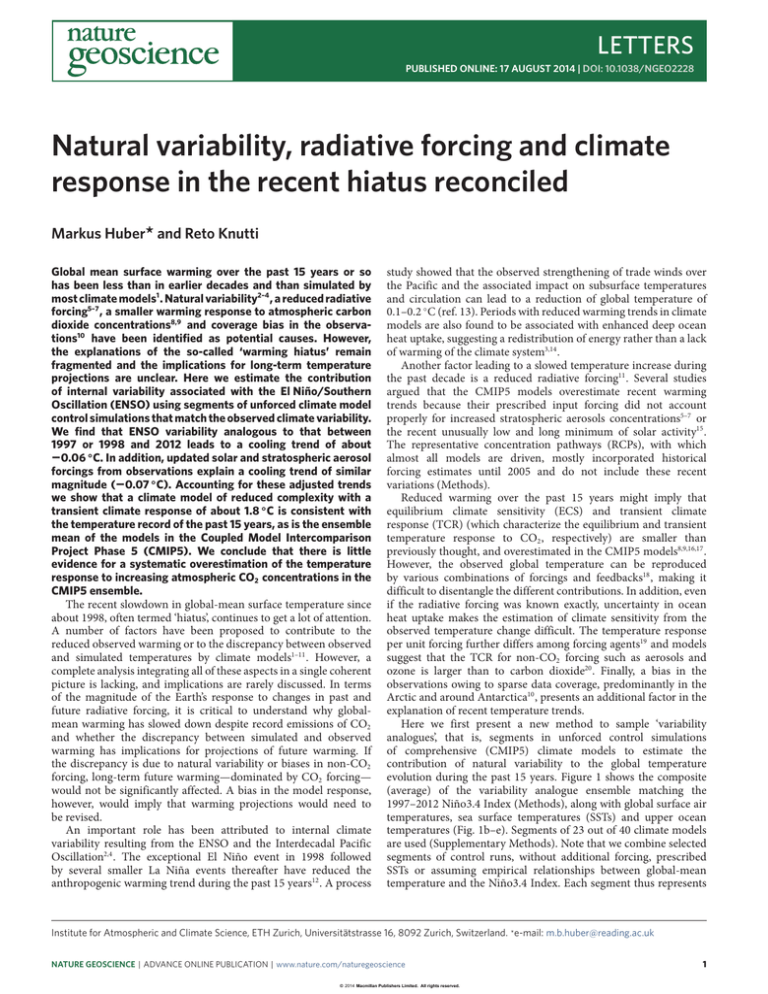
LETTERS
PUBLISHED ONLINE: 17 AUGUST 2014 | DOI: 10.1038/NGEO2228
Natural variability, radiative forcing and climate
response in the recent hiatus reconciled
Markus Huber* and Reto Knutti
Global mean surface warming over the past 15 years or so
has been less than in earlier decades and than simulated by
most climate models1 . Natural variability2–4 , a reduced radiative
forcing5–7 , a smaller warming response to atmospheric carbon
dioxide concentrations8,9 and coverage bias in the observations10 have been identified as potential causes. However,
the explanations of the so-called ‘warming hiatus’ remain
fragmented and the implications for long-term temperature
projections are unclear. Here we estimate the contribution
of internal variability associated with the El Niño/Southern
Oscillation (ENSO) using segments of unforced climate model
control simulations that match the observed climate variability.
We find that ENSO variability analogous to that between
1997 or 1998 and 2012 leads to a cooling trend of about
−0.06 ◦ C. In addition, updated solar and stratospheric aerosol
forcings from observations explain a cooling trend of similar
magnitude (−0.07 ◦ C). Accounting for these adjusted trends
we show that a climate model of reduced complexity with a
transient climate response of about 1.8 ◦ C is consistent with
the temperature record of the past 15 years, as is the ensemble
mean of the models in the Coupled Model Intercomparison
Project Phase 5 (CMIP5). We conclude that there is little
evidence for a systematic overestimation of the temperature
response to increasing atmospheric CO2 concentrations in the
CMIP5 ensemble.
The recent slowdown in global-mean surface temperature since
about 1998, often termed ‘hiatus’, continues to get a lot of attention.
A number of factors have been proposed to contribute to the
reduced observed warming or to the discrepancy between observed
and simulated temperatures by climate models1–11 . However, a
complete analysis integrating all of these aspects in a single coherent
picture is lacking, and implications are rarely discussed. In terms
of the magnitude of the Earth’s response to changes in past and
future radiative forcing, it is critical to understand why globalmean warming has slowed down despite record emissions of CO2
and whether the discrepancy between simulated and observed
warming has implications for projections of future warming. If
the discrepancy is due to natural variability or biases in non-CO2
forcing, long-term future warming—dominated by CO2 forcing—
would not be significantly affected. A bias in the model response,
however, would imply that warming projections would need to
be revised.
An important role has been attributed to internal climate
variability resulting from the ENSO and the Interdecadal Pacific
Oscillation2,4 . The exceptional El Niño event in 1998 followed
by several smaller La Niña events thereafter have reduced the
anthropogenic warming trend during the past 15 years12 . A process
study showed that the observed strengthening of trade winds over
the Pacific and the associated impact on subsurface temperatures
and circulation can lead to a reduction of global temperature of
0.1–0.2 ◦ C (ref. 13). Periods with reduced warming trends in climate
models are also found to be associated with enhanced deep ocean
heat uptake, suggesting a redistribution of energy rather than a lack
of warming of the climate system3,14 .
Another factor leading to a slowed temperature increase during
the past decade is a reduced radiative forcing11 . Several studies
argued that the CMIP5 models overestimate recent warming
trends because their prescribed input forcing did not account
properly for increased stratospheric aerosols concentrations5–7 or
the recent unusually low and long minimum of solar activity15 .
The representative concentration pathways (RCPs), with which
almost all models are driven, mostly incorporated historical
forcing estimates until 2005 and do not include these recent
variations (Methods).
Reduced warming over the past 15 years might imply that
equilibrium climate sensitivity (ECS) and transient climate
response (TCR) (which characterize the equilibrium and transient
temperature response to CO2 , respectively) are smaller than
previously thought, and overestimated in the CMIP5 models8,9,16,17 .
However, the observed global temperature can be reproduced
by various combinations of forcings and feedbacks18 , making it
difficult to disentangle the different contributions. In addition, even
if the radiative forcing was known exactly, uncertainty in ocean
heat uptake makes the estimation of climate sensitivity from the
observed temperature change difficult. The temperature response
per unit forcing further differs among forcing agents19 and models
suggest that the TCR for non-CO2 forcing such as aerosols and
ozone is larger than to carbon dioxide20 . Finally, a bias in the
observations owing to sparse data coverage, predominantly in the
Arctic and around Antarctica10 , presents an additional factor in the
explanation of recent temperature trends.
Here we first present a new method to sample ‘variability
analogues’, that is, segments in unforced control simulations
of comprehensive (CMIP5) climate models to estimate the
contribution of natural variability to the global temperature
evolution during the past 15 years. Figure 1 shows the composite
(average) of the variability analogue ensemble matching the
1997–2012 Niño3.4 Index (Methods), along with global surface air
temperatures, sea surface temperatures (SSTs) and upper ocean
temperatures (Fig. 1b–e). Segments of 23 out of 40 climate models
are used (Supplementary Methods). Note that we combine selected
segments of control runs, without additional forcing, prescribed
SSTs or assuming empirical relationships between global-mean
temperature and the Niño3.4 Index. Each segment thus represents
Institute for Atmospheric and Climate Science, ETH Zurich, Universitätstrasse 16, 8092 Zurich, Switzerland. *e-mail: m.b.huber@reading.ac.uk
NATURE GEOSCIENCE | ADVANCE ONLINE PUBLICATION | www.nature.com/naturegeoscience
© 2014 Macmillan Publishers Limited. All rights reserved.
1
NATURE GEOSCIENCE DOI: 10.1038/NGEO2228
LETTERS
a
Control run of CMIP5 climate model
Variability analogue
Niño3.4
2
0
−2
0
250
500
750
1,000
1,250
1,500
1,750
Months
b
d
Niño3.4 Index
4
Sea surface temperature trend
0.5
2
0.0
(°C)
0
−2
−4
1998
2000
c
2002
2004 2006
Year
2008
2010
−0.5
2012
e
Global surface air temperature
0.3
100
0.2
200
Depth (m)
0.1
(°C)
Global ocean temperature
0
0.0
−0.1
300
400
500
−0.2
600
−0.3
1998
2000
2002
2004
2006
2008
2010
700
2012
−0.2
Year
−0.1
0.0
0.1
0.2
Trend 1997−2012 (°C)
Figure 1 | Estimating the contribution of internal variability to recent temperature trends. a, Illustration of the method used to find segments in the
unforced control simulation of a CMIP5 climate model that match the observed Niño3.4 Index (Methods). The right panel shows one such matching
segment, which we refer to as a ‘variability analogue’. b,c, Evolution of the Niño3.4 Index and global surface air temperature between 1997–2012 for the
variability analogue ensemble (grey lines) and observations (green). The ensemble-mean is denoted with the solid black line, illustrating positive (orange)
and negative (blue) phases of the ENSO. d,e, Linear trend during 1997–2012 for SST (ensemble mean) and global averaged ocean temperatures in the
model composite. Observations29 are shown in green. Note that the long-term warming trend is by definition not present in the variability analogue in e.
an evolution of unforced climate variability in a CMIP5 model that
accounts for partial details in the ocean and atmosphere warming
pattern and is internally consistent from a dynamical as well as from
an energy budget point of view. This contrasts with other methods
that estimate the contribution of internal variability through
simple regressions of an El Niño index to global temperature12,21 .
The average of the segments we select can therefore be seen as a
variability response pattern that emerges from all CMIP5 analogues
available for the recent 15 years of observations.
The constructed composite matches the temporal evolution of
the observations quite well, in particular the transition from an
exceptional strong El Niño to a period with multiple La Niña phases
afterwards. The realization of climate variability as captured by the
analogues indicates a cooling trend of −0.06 ◦ C (±0.12 ◦ C, 1σ ) since
1997 due to ENSO. As we use a relatively long period of about
15 years, the variability composite on average shows slightly less
variance than the observations. The uncertainty in the estimated
trend (Methods) is rather large, indicating that El Niño explains
2
only part of the variability in global temperature. Figure 1c also
shows that the general evolution of inter-annual variability in the
recent observations of global-mean temperature is captured by
this method.
The composite analogue shows the familiar ENSO SST pattern
with a strong cooling in the upwelling region of the equatorial
Eastern Pacific (Fig. 1d). The signal of the variability analogues—
defined by the average SST trend on each grid point divided by the
standard deviation across the ensemble—is highest in this region,
reaching values up to 0.9. The opposite horseshoe-like warming
patterns flanking the cooling region is also evident. Below the
surface, the composite shows on average a cooling in the top 100 m
and enhanced warming in the 100–300 m depth range. The pattern
shows a similar behaviour to the observed ocean warming profile,
except that the variability analogue composite lacks the long-term
warming that is present in the observations, because the former
is derived from control run experiments. Consistent with recent
arguments, the composite shows a positive anomaly in both the deep
NATURE GEOSCIENCE | ADVANCE ONLINE PUBLICATION | www.nature.com/naturegeoscience
© 2014 Macmillan Publishers Limited. All rights reserved.
NATURE GEOSCIENCE DOI: 10.1038/NGEO2228
a
LETTERS
Solar forcing
(W m−2)
0.3
0.2
0.1
0.0
−0.1
1980
1985
1990
1995
Year
RCP
b
2000
2005
PMOD
2010
ACRIM
Stratospheric aerosol forcing
−0.5
(W m−2)
(W m−2)
0.0
−1.0
−1.5
0.0
−0.1
−0.2
1995
−2.0
1980
1985
1990
1995
Year
RCP
0.8
Trend of global temperature: 1998−2012
0.8
CESM (initial-condition ensemble)
0.7
0.6
0.6
0.5
(°C)
0.5
0.4
0.4
0.3
0.3
0.2
0.2
0.1
1995
2000
2005
2010
0.0
Forcing
(°C)
2010
CMIP5
RCP reference set-up
0.7
0.1
1990
2010
2005
GISS-Back
GISS
d
Global temperature
2005
Response
c
2000
2000
1
Year
2
3
4
5
6
Equilibrium climate sensitivity (°C)
Figure 2 | Updated radiative forcings from solar irradiance and stratospheric aerosols and their impact on the recent temperature trends. a,b, Time
series of solar radiative forcing (a) and stratospheric aerosol forcing (b) for the default RCP case (black) and revised data sets of total solar irradiance
(coloured lines) and stratospheric aerosol optical depth (dashed and dotted lines; Methods). Note that in a,b historical estimates in the RCPs run through
2005, and the scenario starts from 2005 onwards. c, Evolution of global temperature derived with a climate model of intermediate complexity for the nine
different forcing cases. The whole twentieth century is chosen as the reference period. d, Trends of global temperature during the 15-year period 1998–2012
for different climate sensitivities of the climate model and the nine forcing scenarios. The total forcing includes all anthropogenic and natural forcings of the
RCP emission scenarios. Values of the CMIP5 climate models and a 20-member initial-condition ensemble of the Community Earth System Model (CESM)
climate model22 are also shown. The arrows illustrate uncertainties associated with radiative forcing and climate response (black) as well as with the
spread in the CMIP5 and CESM ensembles (blue and red, respectively).
and the total ocean heat uptake3,14 corresponding to surface cooling,
but the magnitude is small and the spread across realizations is large.
We next quantify the effect of updated solar and stratospheric
aerosol forcings (Fig. 2a,b) on the global-mean temperature
change since 1990 using an Earth Model of Intermediate
Complexity (EMIC) with an equilibrium climate sensitivity of
3 ◦ C (corresponding to a transient climate response of 1.8 ◦ C). This
model has no internal variability and is thus ideal to study the effect
of forcing and response. Compared with the default RCP forcing
set, our updated forcing leads to a reduction in global temperature
increase since 1998 of the order of −0.04 ◦ C due to solar forcing and
−0.035 ◦ C due to stratospheric aerosol, that is, −0.07 ◦ C combined
(Fig. 2d). Our estimate of the stratospheric aerosol contribution is
slightly lower than previous estimates5,7 .
As climate sensitivity is a parameter in our EMIC, we can
explore its effect on the temperature trend during the past 15 years
(Fig. 2d). Updated forcings reduce the trend by −0.04 ◦ C for a low
sensitivity of 1 ◦ C and −0.08 ◦ C for a high sensitivity of 4.5 ◦ C,
reducing the default RCP trend between by 27% (ECS = 1 ◦ C) to 18%
(ECS = 4.5 ◦ C). For the same period, the ranges of natural variability
in a large initial-condition ensemble22 and in the CMIP5 multimodel ensemble (sampling both natural variability and response
NATURE GEOSCIENCE | ADVANCE ONLINE PUBLICATION | www.nature.com/naturegeoscience
© 2014 Macmillan Publishers Limited. All rights reserved.
3
NATURE GEOSCIENCE DOI: 10.1038/NGEO2228
LETTERS
Climate model of intermediate complexity
Temperature change (°C)
1.0
0.8
ECS = 4 °C
TCR = 1.95 °C
b
Unadjusted
ECS = 5 °C
TCR = 2.10 °C
ECS = 3 °C
TCR = 1.80 °C
ECS = 2 °C
TCR = 1.37 °C
0.6
0.4
0.2
0.0
1982
1.0
Forcing and variability adjusted
Temperature change (°C)
a
0.8
0.6
0.4
0.2
1984
1986
1988
1990
1992
1994
0.0
1996
1998
2000
2002
Year
2004
2006
2008
2010
2012
2006
2008
2010
2012
Year
Mean of CMIP5 climate model ensemble
c
d
0.8
Temperature change (°C)
Temperature change (°C)
1.0
CMIP5 (unadjusted)
CMIP5 (forcing and variability adjusted)
0.6
0.4
0.8
0.6
0.4
0.2
0.2
0.0
1982
1.0
1984
1986
1988
1990
1992
1994
1996
0.0
1998
2000
2002
Year
2004
Year
HadCRUT4 (ref. 30)
Observations:
Cowtan and Way (ref. 10)
Figure 3 | Simulated global temperature adjusted with revised radiative forcings and the effect of internal variability. a,b, Changes of global temperature
with respect to the whole twentieth century are shown for different climate sensitivity values computed with a climate model of reduced complexity
(Methods). For each of the two periods shown, the simulations of the climate models (coloured dashed lines) are adjusted (coloured solid lines) with the
effect of internal variability associated with the observed evolution of ENSO (Fig. 1) and revised radiative forcing (Fig. 2). c,d, Similar to a,b, but for the
ensemble mean temperature change of the CMIP5 climate models. In all panels, observations from two data sets10,30 are shown in black, with the dashed
case attempting to fill in missing data using observations other than those from the surface.
uncertainty resulting from the spread in climate sensitivity) are
given for comparison in Fig. 2d.
Assuming linearity of the effect of the observed climate
variability as captured by the variability analogue composite and the
response of the climate system to revised solar and stratospheric
aerosol radiative forcing, we can then impose these adjustments
onto the simulated global temperature evolution simulated by the
EMIC for different values of climate sensitivity (Fig. 3a) as well
on the average of the CMIP5 climate models (Fig. 3b) for two
15-year-long periods. With a climate sensitivity of 3 ◦ C and a
transient climate response of 1.8 ◦ C, the overall warming of the
twentieth century as well as the year-by-year variations over the
past decades are in good agreement. Adding the forcing corrections
estimated with the EMIC and the natural variability component
from the composite variability analogue to the CMIP5 multi-model
mean gives an estimate of what the CMIP5 ensemble would have
shown with updated forcings and a realization of variability that is
consistent with observations. The resulting model mean agrees well
with the coverage corrected observations10 . Figure 3a demonstrates
that a low climate sensitivity value is less consistent with the total
4
warming over the twentieth century when accounting for updated
forcing and internal variability.
Our ‘variability analogue’ method presented here estimates that
internal variability contributed a cooling trend of −0.06 ◦ C since
1997 to the observed global temperature trend on the basis of
similarities in the evolution of tropical variability as measured
by the Niño3.4 Index in observations and climate model control
simulations. In contrast to other methods, our approach does
not make use of additional forcing or prescribed SSTs. Despite
being selected to match ENSO, each selected segment has a
different realization of global surface air, sea surface and upper
ocean temperature, in particular in the regions not strongly
characterized by ENSO. Therefore, the composite over all segments
mainly shows the ENSO-related contribution that is common
to most segments across CMIP5 models (Methods). Moreover,
it does not include further contributions by other variability
patterns and mechanisms, for example, trends in high-latitude
atmospheric circulation patterns. Variability indices other than
the Niño3.4 Index could be chosen to pick alternative variability
analogue segments.
NATURE GEOSCIENCE | ADVANCE ONLINE PUBLICATION | www.nature.com/naturegeoscience
© 2014 Macmillan Publishers Limited. All rights reserved.
NATURE GEOSCIENCE DOI: 10.1038/NGEO2228
LETTERS
The results presented here do not repeat the attribution of
the observed warming to different causes23 . Nor do they strongly
constrain ECS or TCR from the observed warming, which would
require consideration of uncertainties in all forcings, feedbacks
and heat uptake, and which is known to be difficult given all
uncertainties18 . Rather, they show what current climate models
would have shown if some known systematic deficiencies in forcings
had been considered, and if the models had a similar evolution of
tropical variability. The results do not eliminate the possibility that
some individual models may overestimate past or future warming24 ,
but they show that the temperature response to forcing in the
CMIP5 ensemble as a whole is consistent with the observed warming
and observationally constrained TCR estimates16,25 , in particular
when the coverage bias is taken into account. As a consequence,
recent claims of much lower climate sensitivities and future warming
seem much less plausible. We show that the reduced warming and
mismatch between models and observations since about 1997 or
1998 can, to a large extent, be explained by the combined effect of
reduced forcing and natural variability, each of these components
contributing about an equal amount. Further contributions to the
warming hiatus by other variability mechanisms such as the Atlantic
Multidecadal Oscillation cannot be excluded and uncertainties in
radiative forcing, for example, in tropospheric aerosol forcing,
persist and differ among models. However, we find little evidence
for a biased model response of the CMIP5 ensemble as a whole
and therefore expect long-term warming rates to increase again
if variability and forcing were to shift back to values as in
earlier periods.
Methods
We use monthly mean output of the Coupled Model Intercomparison Project
(CMIP5) for surface air temperature (tas), sea surface temperature (tos) and
ocean potential temperatures (thetao) from 40 climate models for the unforced
control simulations (piControl) as well as the historical forcing scenario from the
RCPs (ref. 26) during the twentieth century until year 2005, followed by the
RCP8.5 scenario. The monthly fields were interpolated on a 2.5◦ × 2.5◦ grid to
compare the different climate models. A list of climate models with information
regarding the length of the control simulation and the model drift is given in the
Supplementary Methods.
For each control simulation of the CMIP5 climate models, we compute time
series of the Niño3.4 Index by averaging monthly SST fields over the Niño3.4
region (5◦ S–5◦ N and 120◦ –170◦ W) and subtract the climatology over the entire
control simulation. The index is normalized by the standard deviation over the
control simulation and then compared with the observed Niño3.4 Index
1997–2012 as illustrated in Fig. 1a. The Niño3.4 observations are based on the
NOAA (National Optical Astronomical Observatories) Optimum
Interpolation Sea Surface Temperature V2 data set (obtained at
www.cpc.ncep.noaa.gov/data/indices/sstoi.indices). We select those segments of
the control simulation that match the evolution of the observations by applying a
correlation criterion of r = 0.6, leading to a set of 52 control segments matching
the Niño3.4 observations. Only 2 of the 52 segments slightly overlap. We choose
the threshold of r = 0.6 to have a balance between the strength of correlation and
the number of members selected into our variability analogue ensemble (see
Supplementary Fig. 1 for a sensitivity analysis of the temperature trend of the
variability ensemble to the correlation threshold).
The impact of a reduced radiative forcing on global mean temperatures is
estimated with the Bern2.5D climate model of intermediate complexity (EMIC;
ref. 27) driven with global-mean radiative forcing series from the RCP archive26 .
In terms of solar forcing, the default RCP set-up is based on solar irradiance data
by ref. 28 and repeats the 23rd solar cycle in the future, but implementations
differ between models. The previous 23rd solar cycle lasted until about the year
2008, and updated records suggest that the minimum in 2009 was substantially
lower than expected from a typical cycle15 . This is not represented in the RCP
set-up. We account for the prolonged solar cycle by using two observational data
sets of total solar irradiance by the Active Cavity Radiometer Irradiance Monitor
(ACRIM) and by the Physikalisch–Meterologisches Observatorium Davos
(PMOD). Both data sets are available at
http://www.acrim.com/TSI%20Monitoring.htm. The two data sets show
differences during their overlapping periods, and we derive radiative forcing time
series for both data sets to account for the observational uncertainty. We also
normalize the derived historical solar forcing to have an average of zero for the
22 years around 1750 (ref. 26).
The RCP forcing data set constitutes also the reference case in terms of
stratospheric aerosol, which is based on previous volcanic stratospheric aerosol
data used in the NASA (National Aeronautics and Space Administration)
Goddard Institute for Space Studies (GISS) climate model up to the year 2001,
followed by zero forcing to the year 2005 (ref. 26). Here, we use updated optical
thickness time series (τ ) from NASA GISS (accessed at
http://data.giss.nasa.gov/modelforce/strataer/tau.line_2012.12.txt) and convert
them to radiative forcing with a conversion factor of −23.5 W m−2 τ −1 , denoted by
GISS in Fig. 2b. We further account for an additional negative radiative forcing
during the period 1960–1990 of about −0.1 W m−2 suggested by observations5 ,
denoted with by GISS-Back in Fig. 2b.
Received 6 March 2014; accepted 17 July 2014;
published online 17 August 2014
References
1. IPCC in Climate Change 2013: The Physical Science Basis
(eds Stocker, T. F. et al.) (Cambridge Univ. Press, 2013).
2. Kosaka, Y. & Xie, S. P. Recent global-warming hiatus tied to equatorial Pacific
surface cooling. Nature 501, 403–407 (2013).
3. Meehl, G. A., Arblaster, J. M., Fasullo, J. T., Hu, A. X. & Trenberth, K. E.
Model-based evidence of deep-ocean heat uptake during surface-temperature
hiatus periods. Nature Clim. Change 1, 360–364 (2011).
4. Meehl, G. A., Hu, A. X., Arblaster, J. M., Fasullo, J. & Trenberth, K. E. Externally
forced and internally generated decadal climate variability associated with the
interdecadal Pacific oscillation. J. Clim. 26, 7298–7310 (2013).
5. Solomon, S. et al. The persistently variable ‘Background’ stratospheric aerosol
layer and global climate change. Science 333, 866–870 (2011).
6. Santer, B. D. et al. Volcanic contribution to decadal changes in tropospheric
temperature. Nature Geosci. 7, 185–189 (2014).
7. Fyfe, J. C., von Salzen, K., Cole, J. N. S., Gillett, N. P. & Vernier, J. P. Surface
response to stratospheric aerosol changes in a coupled atmosphere-ocean
model. Geophys. Res. Lett. 40, 584–588 (2013).
8. Lewis, N. An objective Bayesian, improved approach for applying optimal
fingerprint techniques to estimate climate sensitivity. J. Clim. 26,
7414–7249 (2013).
9. Aldrin, M. et al. Bayesian estimation of climate sensitivity based on a simple
climate model fitted to observations of hemispheric temperatures and global
ocean heat content. Environmetrics 23, 253–271 (2012).
10. Cowtan, K. & Way, R. G. Coverage bias in the HadCRUT4 temperature series
and its impact on recent temperature trends. Q. J. R. Meteorol. Soc.
http://dx.doi.org/10.1002/qj.2297 (2014).
11. Schmidt, G. A., Shindell, D. T. & Tsigaridis, K. Reconciling warming trends.
Nature Geosci. 7, 158–160 (2014).
12. Rahmstorf, S., Foster, G. & Cazenave, A. Comparing climate projections to
observations up to 2011. Environ. Res. Lett. 7, 044035 (2012).
13. England, M. H. et al. Recent intensification of wind-driven circulation in the
Pacific and the ongoing warming hiatus. Nature Clim. Change 4,
222–227 (2014).
14. Trenberth, K. E. & Fasullo, J. T. An apparent hiatus in global warming? Earth’s
Future 1, 19–32 (2013).
15. Frohlich, C. Total solar irradiance observations. Surv. Geophys. 33,
453–473 (2012).
16. Otto, A. et al. Energy budget constraints on climate response. Nature Geosci. 6,
415–416 (2013).
17. Gillett, N. P., Arora, V. K., Flato, G. M., Scinocca, J. F. & von Salzen, K.
Improved constraints on 21st-century warming derived using 160 years of
temperature observations. Geophys. Res. Lett. 39, L01704 (2012).
18. Knutti, R. & Hegerl, G. C. The equilibrium sensitivity of the Earth’s
temperature to radiation changes. Nature Geosci. 1, 735–743 (2008).
19. Hansen, J. et al. Efficacy of climate forcings. J. Geophys. Res. 110,
D18104 (2005).
20. Shindell, D. T. Inhomogeneous forcing and transient climate sensitivity. Nature
Clim. Change 4, 274–277 (2014).
21. Thompson, D. W. J., Wallace, J. M., Jones, P. D. & Kennedy, J. J. Identifying
signatures of natural climate variability in time series of global-mean
surface temperature: Methodology and insights. J. Clim. 22,
6120–6141 (2009).
22. Fischer, E. M., Beyerle, U. & Knutti, R. Robust spatially aggregated projections
of climate extremes. Nature Clim. Change 3, 1033–1038 (2013).
23. Huber, M. & Knutti, R. Anthropogenic and natural warming inferred from
changes in Earth’s energy balance. Nature Geosci. 5, 31–36 (2012).
24. Stott, P., Good, P., Jones, G., Gillett, N. & Hawkins, E. The upper end of climate
model temperature projections is inconsistent with past warming. Environ. Res.
Lett. 8, 014024 (2013).
NATURE GEOSCIENCE | ADVANCE ONLINE PUBLICATION | www.nature.com/naturegeoscience
© 2014 Macmillan Publishers Limited. All rights reserved.
5
NATURE GEOSCIENCE DOI: 10.1038/NGEO2228
LETTERS
25. Collins, M. et al. in Climate Change 2013: The Physical Science Basis
(eds Stocker, T. F. et al.) 1029–1136 (Cambridge Univ. Press, 2013).
26. Meinshausen, M. et al. The RCP greenhouse gas concentrations and their
extensions from 1765 to 2300. Climatic Change 109, 213–241 (2011).
27. Stocker, T. F., Wright, D. G. & Mysak, L. A. A zonally averaged, coupled
ocean atmosphere model for paleoclimate studies. J. Clim. 5,
773–797 (1992).
28. Lean, J. L. & Rind, D. H. How will Earth’s surface temperature change in future
decades? Geophys. Res. Lett. 36, L15708 (2009).
29. Levitus, S. et al. World ocean heat content and thermosteric sea level change
(0–2000 m), 1955–2010. Geophys. Res. Lett. 39, L10603 (2012).
30. Morice, C. P., Kennedy, J. J., Rayner, N. A. & Jones, P. D. Quantifying
uncertainties in global and regional temperature change using an ensemble of
observational estimates: The HadCRUT4 data set. J. Geophys. Res. 117,
D08101 (2012).
6
Acknowledgements
We thank U. Beyerle for the technical support of the climate model and J. Sedlacek for
helping with the CMIP5 data.
Author contributions
M.H. performed the climate model computations and analysis. Both authors designed
the study and wrote the paper.
Additional information
Supplementary information is available in the online version of the paper. Reprints and
permissions information is available online at www.nature.com/reprints.
Correspondence and requests for materials should be addressed to M.H.
Competing financial interests
The authors declare no competing financial interests.
NATURE GEOSCIENCE | ADVANCE ONLINE PUBLICATION | www.nature.com/naturegeoscience
© 2014 Macmillan Publishers Limited. All rights reserved.


